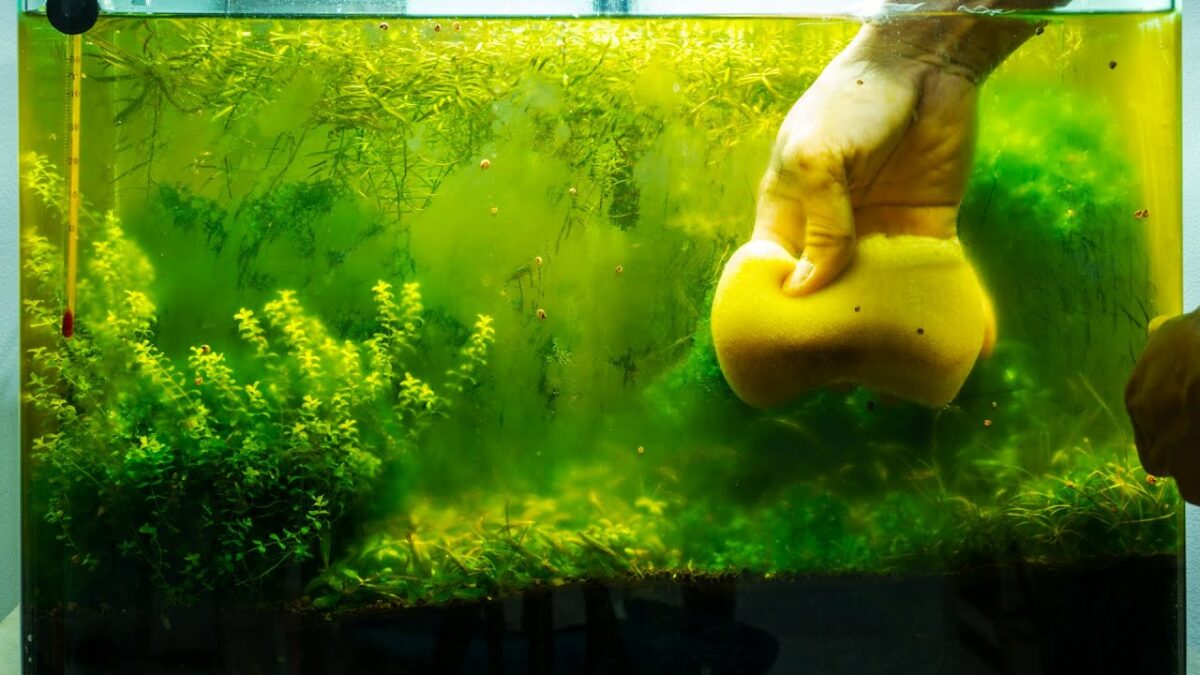Unfortunately, aquarium algae is something every tank owner has to deal with, sooner or later.
It can be very frustrating when some algae types appear and you don’t know how to save your aquarium population. Especially because there are so many different types of aquarium algae.
This is why we suggest you read this extensive guide, which not only has all these fish tank algae types listed but also tells you how to treat and prevent them.
Plus, we give you some suggestions for algae eaters that can improve the appearance of your tank, and keep these invasions under control or remove them.
Contents
1. Black Beard Algae (Audouinella/Black Brush Algae/BBA)
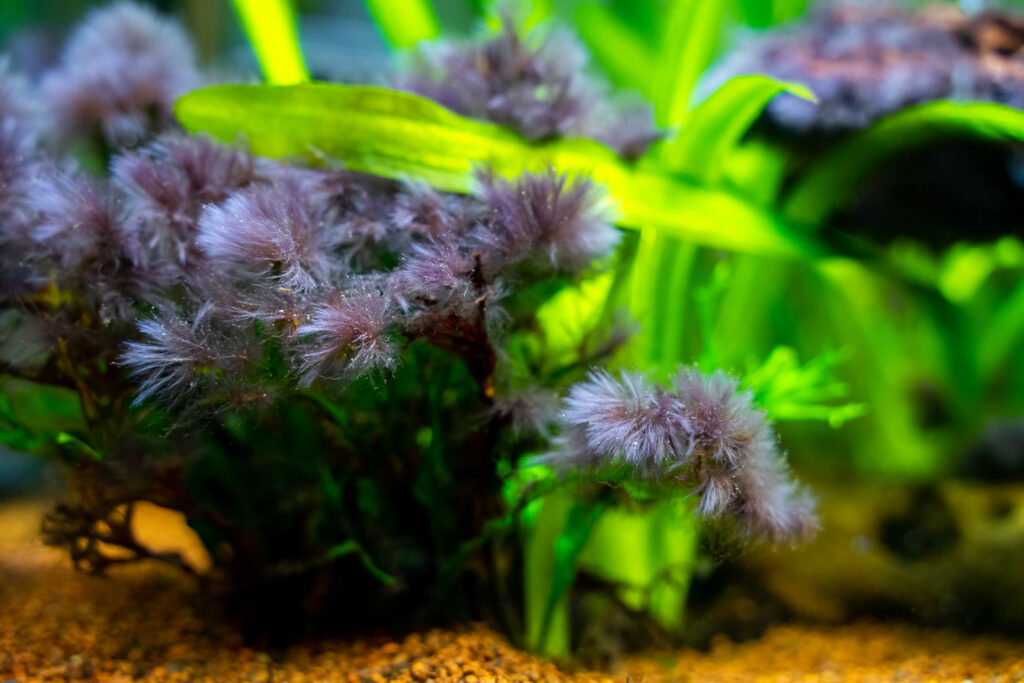
- Common Causes of Black Beard Algae
The most common algae you find is the beard algae, a type of red algae, in saltwater fish tanks, but it can also appear in freshwater aquariums.
It’s really annoying and hard to remove. This algae type grows quickly in soft and slippery patches on plants, driftwood, bogwood, and any hard surfaces in the aquarium. And, it kind of looks like a beard, which explains its name.
This algae grows and gets all its nutrients from photosynthesis. From this process, the black brush algae produces a red light protein called phycoerythrin, giving the BBA’s purplish-black appearance, hence its name.
- How to Get Rid of Black Beard Algae
Luckily, you can get rid of black beard algae before it spreads.
First of all, to avoid it from happening in the first place, make sure you have consistent tank lighting, stable and high CO2 conditions. This way, you won’t have any risks of BBA existing in your tank.
If it’s too late and it’s already growing, you can try to remove the algae manually or with an algae scraper.
This doesn’t always work if there’s too much propagation, and it’s a tough, slow process. So if the BBA is really resistant, remove all your items from your tank, including other plants and decorations.
Then, pour bleach in a water solution and leave it on the infected plants and black beard algae for two minutes or so. It should be a 1 to 20 ratio bleach. Make sure you wear gloves and protective gear and that the bleach doesn’t go anywhere.
- Black Beard Algae Eaters
There’s always the solution of adding black beard algae eaters in your tank. You could, for example, get Amano shrimp, or get Siamese algae eaters, or Florida Flag fish if you prefer to maintain a strictly fish tank.
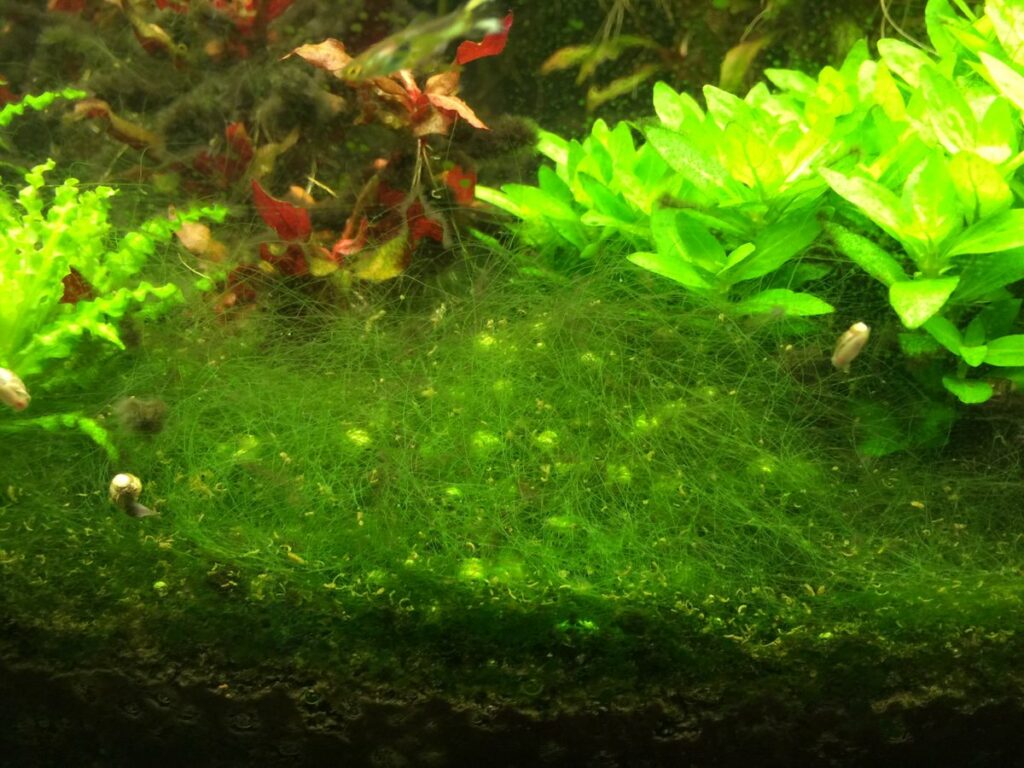
2. Blanket Weed (Cladophora sp.)
- Common Causes of Blanket Weed
Often, blanket weed comes from low-quality plants. Marimo Balls are the common inducers.
This algae type can then grow quickly if the CO2, nitrate, and light levels in your tank are too high. But it can also grow in healthy water conditions, so it’s a really annoying algae species. Plus, it smells bad if you crush it.
So make sure that all your plants are high quality and keep the right water conditions in your tank.
- How to Get Rid of Blanket Weed
We feel for you if you have blanket weed in your tank, and we know the struggle. These algae are very hard to remove as they stick to hard items, substrate, and hair grass.
So if you want to get rid of them, we can only wish you good luck. If it’s a small infestation, you can remove these algae using long tweezers and turning off the water current.
Ideally, prevent infestations by quarantining all new plants.
- Blanket Weed Algae Eaters
Unfortunately, there are no blanket weed algae eaters that we know of. So you really don’t want to have infestations in your tank in the first place.
It’s practically impossible to remove, which is why it’s important to reduce the chances of algae appearing by quarantining plants and keeping the same water conditions.
A small invasion can sometimes be removed with tweezers. If you have too big of an invasion, you most probably need to throw away your tank.
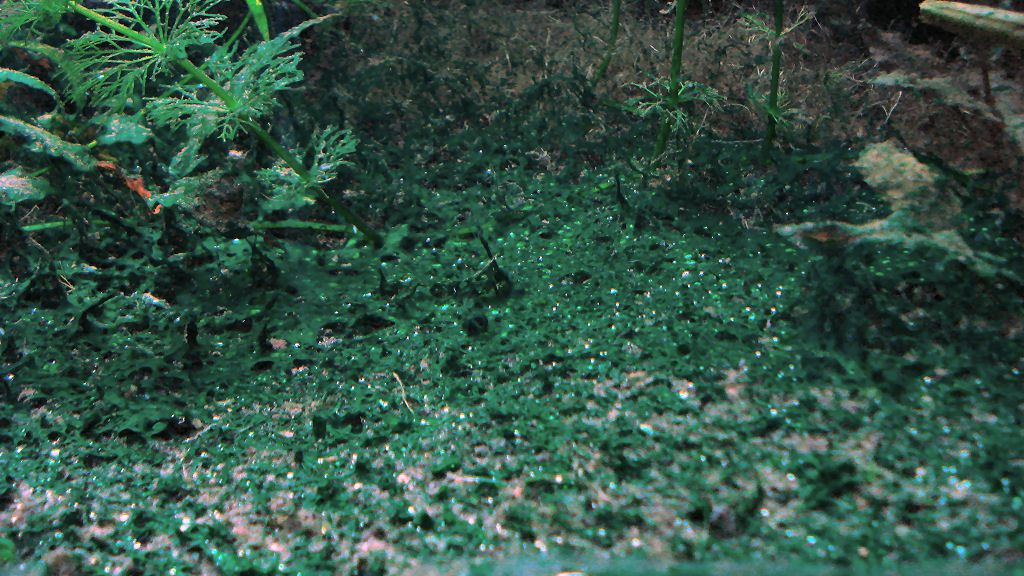
3. Blue-Green Algae (BGA)
- Common Causes of Blue-Green Algae
This is more of a bacterium than an algae type. In fact, it’s a cyanobacterium and a nitrogen-fixing bacteria which is able to photosynthesize.
Not only is it extremely annoying to have an invasion of blue-green algae, but it also removes all nitrogen from your tank.
It grows really quickly, too, and leaves a nasty smell in your aquarium. BGA often comes from a high presence of organic waste, which is a result of overfeeding, or it could come from too much light or no water changes and poor water circulation.
- How to Get Rid of Blue-Green Algae
To get rid of blue-green algae, you could add fast-growing plants to your aquarium to out-compete nitrate levels, which kills BGA. Or you could use an Excel or Maracyn treatment with a syringe and then manually remove any residue.
Another popular method to get rid of BGA is the ‘Black-out’ technique, but you should only use this as a last resort. For this, change 50% of your tank’s water and manually remove as much algae as you can.
Then, test your nitrate levels, and if they’re too low, add potassium nitrate until the levels are at 20 ppp. You can add an airstone, cover the tank, so no light gets in for three to four days. Your tank population should be fine without food.
After a few days, test your nitrate levels again and remove the airstone. Check your filter and substrate and check if the water circulation is good. Then, remove any algae residue manually or with a syringe.
- Blue-Green Algae Eaters
Unfortunately, there are no known blue-green algae eaters at the moment. The best thing you can do is prevent this algae type from growing in the first place.
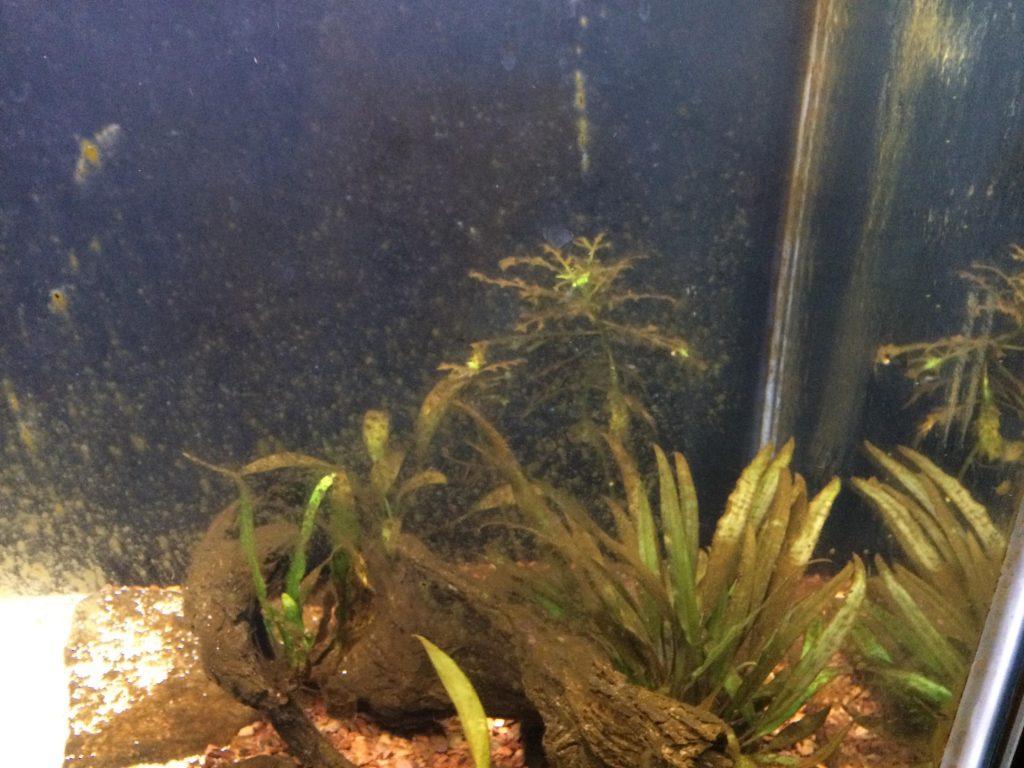
4. Brown Algae (Diatoms)
- Common Causes of Brown Algae
Brown algae, a form of diatom, can cover your aquarium, plants, and substrate in a slimy film. You can find them both in freshwater and marine aquariums.
They can grow with photosynthesis or even in low-light conditions, as long as they have enough nutrients like silicates, nitrates, and phosphorus.
Diatoms can happen if the levels of silicates, phosphorus, or nitrates are too high in your aquarium, or if there are inadequate light levels, or if the oxygen levels are too low.
These algae often appear in new aquariums, as the tank’s substrate and the filter during the nitrogen cycles don’t have time to mature.
- How to Get Rid of Brown Algae
Ideally, to get rid of brown algae, you should remove all the nutrients it uses to grow. This can easily be done with a water change. Most importantly, wait for your water cycle to mature.
Also, check your lighting. It can’t be too much or too little, so you might want to readjust your lighting schedule. Avoid natural sunlight.
If your tank doesn’t have enough oxygen, you can add an air pump, a long airstone, and get a stronger tank filter.
You can then vacuum all the algae or remove it manually with a soft cloth.
- Best Brown Algae Eaters
Three fish species are great to keep your tank clean and clear from brown algae. These are Yellow Tangs, Otocinclus Catfish and Plecostomus and can help remove any residue of little invasions of brown algae.
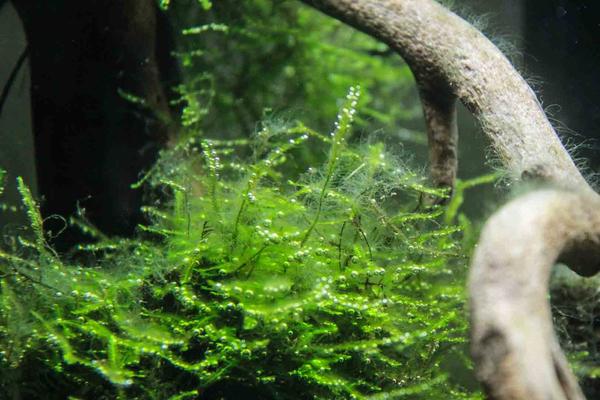
5. Fuzz Algae
- Common Cause of Fuzz Algae
Fuzz algae often appear in new aquarium setups. These short green algae types grow on your plants, on your tank’s glass, and decorations as individual filaments.
Some aquarists believe these algae are the early stage of hair algae.
Most often, fuzz algae appear in new tank setups because the nutrients tend to be imbalanced since they’re not mature yet.
Also, if the oxygen levels are low, that could explain why you have fuzz algae in your aquarium.
- How to get rid of Fuzz Algae
You can prevent fuzz algae by keeping good and consistent oxygen levels.
Also, you can test your aquarium’s nutrient level and adjust accordingly. Or, you could add some fuzz algae eaters to your tank to remove any remains you can’t remove by hand.
- Fuzz Algae Eaters
There are actually a lot of fuzz algae eaters, which can help you keep your fuzz algae population in check.
You could try adding one of these to your tank: Amano shrimp, Otocinclus, Black Mollies, Siamese Algae Eaters, Bristlenose Plecos.
6. Green Aquarium Water Algae
- Common Causes of Green Water Algae
Most freshwater aquarium owners fear green water algae. That’s because it turns the tank green and can grow very fast because green water algae are a singular celled organism. The silver lining is that they’re not toxic for your fish.
These algae grow with photosynthesis and either appear when there’s a spike in nutrients or lights.
So avoid exposing your aquarium to direct sunlight and keep the tank’s nutrient levels in check. Most times, nutrient levels rise when you overfeed your fish, creating organic waste.
- How to get rid of Green Water Algae
Since green water algae is a single-cell organism, it replicates not just quickly but very quickly.
So water changes won’t help because of this fast propagation. Even if you change almost all of the entire water, these algae will come back within two days or so.
What you need to do is to kill all the green water algae in your fish tank. You could either use the black-out method, as mentioned previously, or you could use a UV sterilizer.
If you have other plants in your aquarium, you should use the last method, as it won’t damage them as much.
- Green Water Algae Eaters
Any type of snails or shrimps are great green water algae eaters. Just be careful that your fish don’t eat them or that they’re not absorbed by the tank’s filter.
7. Green Dust Algae (GDA)
- Common Causes of Green Dust Algae
You can easily confuse green spot algae with green spot algae, but they’re not the same. GDA forms green slime over the glass while GSA grows in spots.
Green dust algae mostly occur in newly planted aquarium setups, where it’s too early for healthy bacteria to form and to have a regular full cycle.
However, new aquariums are not the only ones who can get GDA. More mature ones can get this algae type too. Usually, it’s caused by low levels of nutrients and/or low oxygen levels.
- How to Get Rid of Green Dust Algae
Now, this might seem a bit confusing, but the best thing you can do to get rid of green dust algae is to do nothing.
That’s right, doing nothing and allowing the green dust algae to run its full cycle helps to get rid of it.
Their life cycle usually lasts about a month. So leave them for four weeks, and don’t remove any of them manually, as they can release spores, which then recreates another life cycle. So you have to be patient and just let it run its natural cycle.
I know it’s tempting to wipe the spots, but it only makes things worse. After the month period is done, lower the water level as much as possible and change the water. Then, you can finally wipe the algae.
Some hobbyists think that replacing light bulbs after you perform a water change can remove GDA, but this doesn’t always work, so stick with the previous method.
- Green Dust Algae Eaters
Bristlenose Plecos are great to eat any green dust algae.
8. Green Spot Algae (GSA/Coleochaete Orbicularis)
- Common Causes of Green Spot Algae
Now that you know what the difference is between GDA and GSA let’s dive into the last algae type (no pun intended).
These tiny green spots can grow anywhere, including decorations, tank equipment, and even slow-growing plants. These dots can even transform into wide coats if you don’t remove them.
So what causes them, and how can you prevent them from growing? Green spot algae often appear when there’s a nutrient imbalance in an aquarium.
Typically, imbalances happen in newer tanks, as there’s not enough time for healthy bacteria to grow or nutrients to fully develop.
They can also occur if you don’t change the tank’s water regularly, or if the phosphate levels are not enough, or if the fertilization isn’t adequate.
Other common causes include low oxygen levels, bad water circulation, exposing your tank to direct sunlight or any other light sources for too long.
- How to Get Rid of Green Spot Algae
First, to get rid of GSA, you need to check the nutrient levels, especially phosphate. If the levels are too low, adjust accordingly.
Once the phosphate levels are high enough, you can remove all of the algae with an algae scraper.
Also, make sure you don’t leave lights on for too long. Nine hours is usually enough for most fish tanks.
- Green Spot Algae Eaters
Snails are particularly great green spot algae eaters, especially Sun snails and Nerite snails.

9. Hair/Thread Algae
- Common Causes of Hair/Thread Algae
Hair algae are a type of filamentous algae that leave long, soft, and loose threads on plants, decoration, or even gravel. They feel like wet hair, hence their name.
The common causes of their appearances are a nitrate deficit, low oxygen levels, or too much light. It could also be an oversaturation of nutrients or too little of them.
- How to get rid of Hair/Thread Algae
Hair algae can be hard to get rid of completely, but you can test the nutrient levels and adjust accordingly, for starters.
Also, make sure there’s not too much light entering your tank and that the oxygen levels are fine and stable.
You can then remove the algae manually or siphon them out when you perform a water change.
- Hair/Thread Algae Eaters
For hair algae eaters, you could add shrimps to your aquarium, such as Amano shrimps or Dwarf shrimps.
If you prefer to have a fish-only aquarium, here are the ones you can add that will eat all the nasty thread algae in your tank: Florida Flag fish, Mollies, or Siamese Algae Eaters.
10. Oedogonium Algae
- Common Causes of Oedogonium Algae
Oedogonium algae are a type of short filamentous algae that usually attach themselves to plants, which gives them a green fuzzy look. Sometimes, they can be free-floating.
Usually, these algae appear when the oxygen levels in your aquarium are too low. A nutrient deficiency could also cause this, so you can test the levels and adjust accordingly.
These algae can appear in more mature tanks as well as newer ones, so make sure you monitor your aquarium closely! Prevention is always the best method.
- How to get rid of Oedogonium Algae
To get rid of these algae, check your nutrient and oxygen levels, and adjust accordingly. This should remove them, and if not, you could add some Excel product into your tank.
Then, you can just wipe off any algae residue.
- Oedogonium Algae Eaters
Here are the most common oedogonium algae eaters: mollies, Amano shrimps, and Rosy Barbs. Check which ones fit your aquarium best!
11. Rhizoclonium Algae
- Common Causes of Rhizoclonium Algae
Rhizoclonium Algae are a genus of green algae from the Cladophoraceae family, to be more specific.
These algae look similar to hair algae and leave green or brown slimy strands in your aquarium.
By now, you probably realize that most algae types exist because of similar reasons, and these algae are no exception.
If you don’t maintain your aquarium or have poor water circulation, Rhizoclonium Algae appear because they thrive on that.
They could also come because the tank’s water nutrient levels are too low or because there’s too little oxygen.
All of these are easily preventable, and you can usually fix these problems as well.
- How to get rid of Rhizoclonium Algae
Ideally, keep your aquarium in top shape to avoid rhizoclonium algae from growing, or any other ones, as a matter of fact.
These algae can be difficult to remove, so you want to avoid them as best as you can. However, if you have them in your tank, you can check the nutrient levels and adjust accordingly.
Then, you can give your tank a good clean and increase the oxygen levels there and the water circulation.
Products like Excel can also help in high quantities, but watch out for your tank population and act accordingly.
- Rhizoclonium Algae Eaters
Amano shrimps are great rhizoclonium algae eaters. So consider them if you want a clean tank, free from these slimy algae.
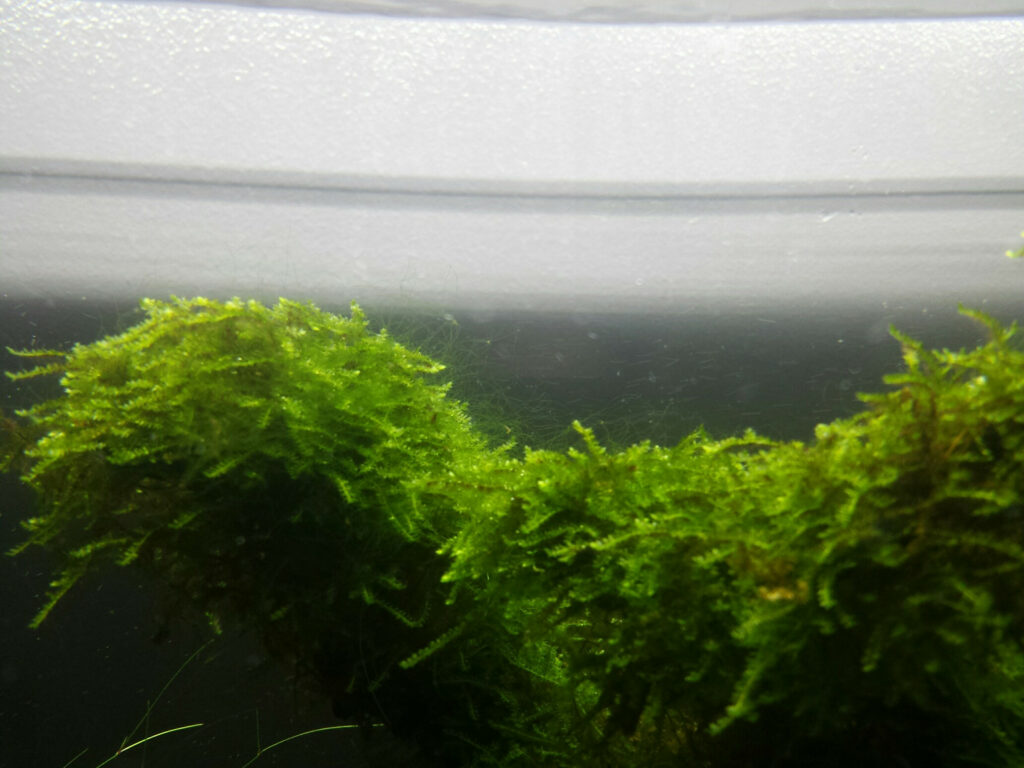
12. Spirogyra
- Common Causes of Spirogyra
Spirogyra algae are yet another type of filamentous green algae. They form very quickly, and you can spot them easily, as they’re fine slippery bright-green strands spread throughout your aquarium.
They can grow because of ammonia spikes, overfeeding, or because you don’t maintain your tank, but it’s hard to pinpoint exactly.
- How to get rid of Spirogyra
It can be hard to get rid of these algae, as they like the same water conditions as your regular aquarium plants.
However, you can perform a blackout for three days, change the water daily, and remove as many algae as you can manually.
The blackouts have to have no oxygen, so make sure you take care of your tank population and place them somewhere else.
Or, you could try a Hydrogen Peroxide treatment.
- Spirogyra Algae Eaters
Rosy Barbs are ideal for eating all the spirogyra algae in your aquarium.
13. Staghorn Algae (Compsopogon sp.)
- Common Causes of Staghorn Algae
Staghorn algae belong to the red algae group, so they’re easy to spot!
Most often, they grow because of poor water circulations, low oxygen, high levels of ammonia, or all these. It could also be that you’re overfeeding your fish or not maintaining your aquarium properly.
- How to get rid of Staghorn Algae
These algae are hard to remove manually. So you can do a bleach treatment by dipping the affected plants and items in bleach.
Also, keep on top of your tank’s maintenance, check the nutrient levels and adjust accordingly, and perform weekly water changes. You can also increase oxygen levels and improve water circulation.
- Staghorn Algae Eaters
Amano shrimps are great staghorn algae eaters. Just be careful that your fish don’t eat them!
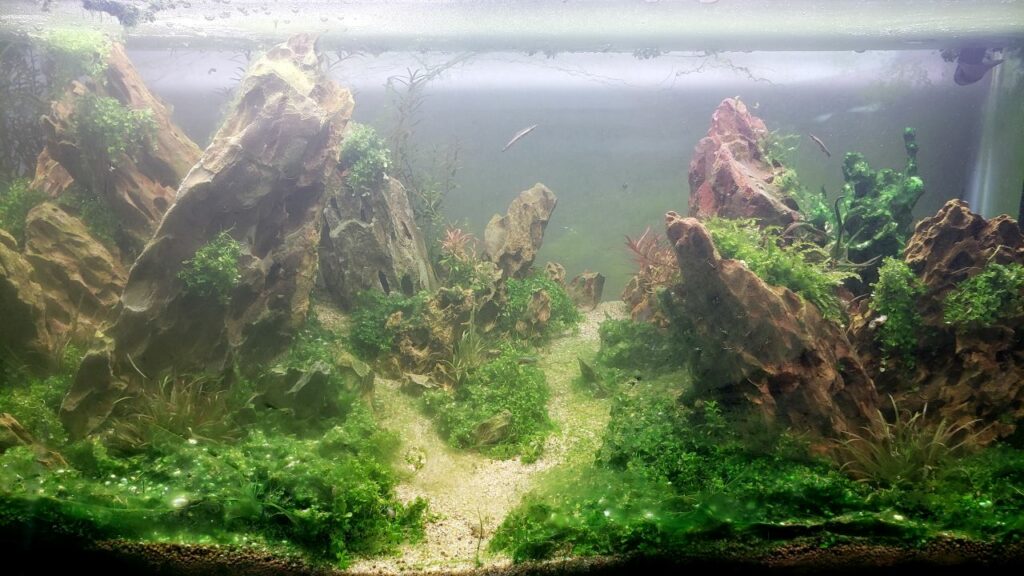
Final Algae Thoughts and Tips
As you can see, as long you keep the tank’s algae production low, it should be fine. Ideally, you should prevent them from growing in the first place, for which you can find all these recommendations above.
Here are more tips that are useful to prevent any type of aquarium algae:
- Don’t Overfeed Your Fish
Organic food waste can often be a source of growth for aquarium algae, so don’t overfeed your fish. Not only will the tank be cleaner, but it will also keep the algae population low and will keep your fish healthy.
It’s not good for them to eat too much. It can cause diseases and drastically reduce their lifespan.
- Control Your Lighting (Avoid Direct Sunlight)
Keep the lighting as regular as possible. There can’t be too much or too little of it. Also, try to avoid direct sunlight on your tank. This prevents algae from growing.
- Raise the Competition
You could also try to introduce new plants to the aquarium so that the water resources can be equally distributed. So raise the competition to keep the algae invasion in check.
- Keep on top of Water Changes
Make sure you regularly change the water of your aquarium. Ideally, each week changes about 10 to 15% of the total water.
- Test Your Water Source
The next thing you’ve got to keep track of is your water source. Make sure the water conditions stay the same and are appropriate to your tank population.
Often, tap water can have high levels of phosphates and nitrates, which are fertilizers for aquarium algae.
So keep these levels low, and you can use a phosphate remover to do so. Or, you could also use a reverse osmosis system if you’d prefer to have pure water and remove all pollutants.
- Keep A Cleanup Crew
A cleanup crew is not only great to add some life and aesthetics to your aquarium, as well as to keep your tank free from any algae, or to reduce the algae invasion.
Different types of aquarium algae require different tank cleanup crews, so make sure you follow our recommendations for each of them.
When you add any algae eaters in your tank, always check they’re compatible with other tank mates and what care they require.
If you follow all these tips, your aquarium algae population should be nonexistent or very low. So there you go, now you’re ready to fight any type of algae invasion in your aquarium!

Ian Sterling, founder of Fishlab.com, began his aquarium journey over 30 years ago, driven by a deep fascination for fish and their diverse personalities. His website, Fishlab.com, is dedicated to making fishkeeping accessible and enjoyable, offering beginner-friendly guidance, expert insights, and a community for aquarists to connect and share experiences.


